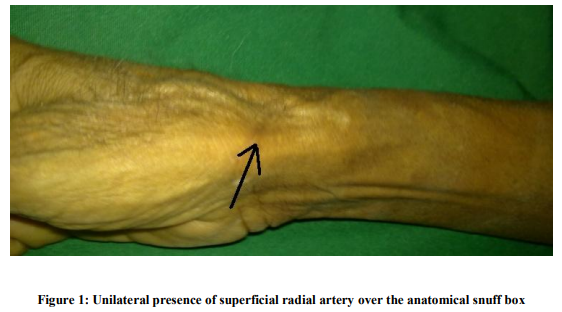IJCRR - 5(13), July, 2013
Pages: 93-94
Date of Publication: 17-Jul-2013
Print Article
Download XML Download PDF
UNILATERAL ANATOMICAL VARIATION OF RADIAL ARTERY - CLINICAL IMPLICATION OF SUPERFICIAL RADIAL ARTERY
Author: Prabha Udayakumar, Vinodhadevi, Vijayakumar D.A.
Category: Healthcare
Abstract:The anatomical variations with respect to the origin of radial artery has been reported extensively in the literature. The incidence of superficial radial artery is 0.5% and associated with high origin of radial artery. Awareness about normal variation and the possibility of unilateral variation of radial artery course could prevent complications during intravenous and arterial cannulation in the upper limb.
Keywords: Unilateral Anatomical variation, Superficial Radial Artery, Arterial cannulation
Full Text:
INTRODUCTION
A 65yr old male patient belonging to American Society of Anesthesiologists Class 3 was posted for Thoracic Pott’s spine decompression and stabilisation. A wide bore intravenous cannulation and an arterial cannulation was planned for invasive monitoring. An abnormal pulsation of the blood vessel in the origin of cephalic vein region was noted on the right distal forearm as we were about to cannulate the cephalic vein (Fig 1). Normal radial artery pulsation on the right side was absent. Surprisingly, the radial artery course on the distal left forearm was normal and was cannulated. Postoperatively, we confirmed that there was no history of bony or soft tissue injury. The anatomical variations with respect to the origin of radial artery has been reported extensively in the literature by anatomists. The incidence of superficial radial artery is 0.5% and associated with high origin of radial artery.1 Abnormal course of radial artery and its implications during percutaneous coronary intervention and radial artery graft retrieval during coronary artery bypass grafting, has been reported by interventional cardiologist 2 and cardiothoracic surgeons.3 Anaesthetic implication of such variation would be inadvertent arterial cannulation and accidental injection of the drugs intra-arterially. Inadvertent injection of drugs intra-arterially, would lead to arterial spasm, gangrene.4 To conclude, awareness about normal variation and the possibility of unilateral variation of radial artery course could prevent complications during intravenous and arterial cannulation in the upperlimb. All medical personnel should be aware of such variations and to be borne in mind even during simple procedures like intravenous cannulation. Whenever Cephalic vein is prominent or tortuous do look for the pulsatality of the vessel before cannulation.
References:
1. Rodríguez-Niedenführ M, Vázquez T, Nearn L, Ferreira B, Parkin I, Sañudo JR. Variations of the arterial pattern in the upper limb revisited: a morphological and statistical study, with a review of the literature. J Anat 2001;199:547-566.
2. Jelev L, Surchev L. Radial artery coursing behind the bicepsbrachii tendon: significance for the transradial catheterization and a clinically oriented classification of the radial artery variations. Cardiovasc Intervent Radiol 2008;31:1008-1012.
3. Alameddine AK, Alimov VK, Engelman RM, Rousou JA, Flack JE 3rd, Deaton DW, Engelman DT. Anatomic variations of the radial artery: Significance when harvesting for coronary artery bypass grafting. J Thorac Cardiovasc Surg 2004;127:1825-1827.
4. MacPherson RD, McLeod LJ, Grove AJ. Intra-arterial thiopentone is directly toxic to vascular endothelium. Br J Anaesth 1991;67:546-552

|






 This work is licensed under a Creative Commons Attribution-NonCommercial 4.0 International License
This work is licensed under a Creative Commons Attribution-NonCommercial 4.0 International License